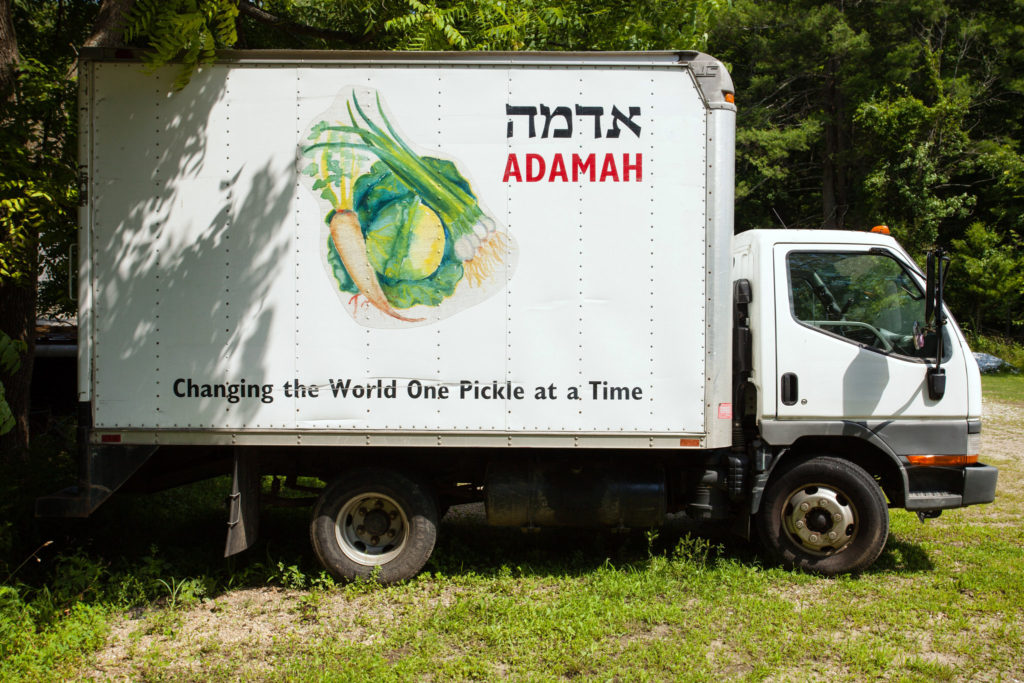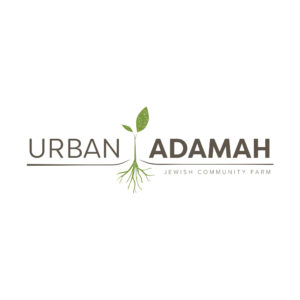Jewish Farming and the Climate Crisis
How Jewish farming organizations are working to combat climate change

(Photo courtesy of Robert Wright for the New York Times.)
On a hot Friday in July 2015, I spent the afternoon trying to find and clear space for a few rows of squash that were so overrun by weeds that the plants were hard to locate. This was not the kind of careful weeding I had done previously in other areas of the farm at Adamah, the Jewish Farming Fellowship in Falls Village, Connecticut, one of several Jewish farming communities in the United States. The Adamah farming fellowship is an immersive social justice agricultural program for young Jewish adults. The Farm Director, Janna Siller, scheduled the farm fellows for speed weeding just one afternoon a week at the Sadeh, Hebrew for “the field.” They had only planted crops in one quarter acre of that four-acre field. While the Sadeh’s soil is especially rich, planting there was risky because it was susceptible to flooding. After a complete and devastating loss when the field flooded after Hurricane Irene in 2011, Adamah moved their main operation to another field. The weekly weeding session at the Sadeh was part of what Siller called their “hail Mary” effort. If anything survived the season, it would add to their fall harvest; if not, at least they hadn’t wasted much time. Unfortunately, the Sadeh has flooded almost every year since then and Adamah has stopped using the field completely.
At Jewish farms like Adamah, the climate crisis and its resulting extreme weather patterns are neither a future problem nor a political issue to debate. The climate crisis shapes people’s work on their farms and their engagement with Judaism.
Adamah was founded in 2004 as the first contemporary Jewish community farming organization in the United States. Since then, they have been joined by other groups across the country and in Canada. These organizations use their land, resources, and networks to mitigate climate change through diverse methods, including ecological restoration and reforestation, pollinator repopulation, seed development, and political advocacy. Though this contemporary Jewish farming movement is relatively new, Jews have previously turned to farming when faced with similar uncertainty about how to ensure a better world than the one they inherited. They are doing the same today.
A Brief History of Jewish Farming in the United States
People are often surprised to hear that there are more than twenty Jewish community farming organizations in North America and hundreds more Jewish farmers. But Jewish farming is not new.
In the late nineteenth-century, waves of Jewish immigrants flooded American shores to seek out a more stable future than the one offered to them in Eastern Europe. After Russia instituted the May Laws of 1882, which restricted Jewish access to schools and governmental positions, Jews faced violence from widespread pogroms, massacres that were organized by Russian Christians. As Jewish immigrants fled persecution and violence in Eastern Europe, a number of organizations formed quickly in Europe and the United States to assist them. The Hebrew Emigrant Aid Society, or HEAS (now HIAS), formed in 1881 to help Jews fleeing oppression settle in the United States and learn about agriculture. HEAS was joined in this work by Am Olam (“Eternal People”), a movement dedicated to creating socialist agricultural communities in an effort to prove that Jews could be self-sufficient in the United States and what was then Palestine. Historian Uri Herscher quoted a member of Am Olam in his book Jewish Agricultural Utopias in America who declared, “Our motto is labor in the fields, and our goal is the physical and spiritual rejuvenation of our people.” At a time when the future of the Jewish people felt uncertain, farming uplifted Jewish immigrants and gave them hope in a new land.
The Jewish agricultural communities established in the United States were diverse. Early Jewish farming communities, commonly called colonies in the United States and kibbutzim in Palestine, were based on communist models of shared labor, hard work, and simple lives. Later communities permitted individual land ownership and bound colonists together with a shared set of beliefs. Jewish farming colonies were established in the Dakotas, Oregon, Louisiana, Michigan, Utah, Colorado, Kansas, New Jersey, and Ohio.
None of the American Jewish farming colonies lasted more than a few generations, even as the kibbutzim thrived. But the legacy of those American Jewish farms continues today with a new cohort of farmers who, faced with the climate crisis, are concerned about the future of the Jewish people, the Earth, and its inhabitants. And just as the Jewish farmers of the nineteenth century turned to their ancient agricultural roots when they faced crises of antisemitic violence, so too is the contemporary Jewish farming movement drawing on ancient Jewish teachings to face the climate crisis head on.
The Contemporary Jewish Community Farming Movement
The Jewish communal farming movement is, to use a term a bit too on the nose, a grassroots effort. Each farming organization was created to address the specific goals and needs of a defined community. Jewish farming organizations are joined by a common dual focus on environmental and food justice and each is responding to environmental degradation and the climate crisis, even as their strategies vary widely.
 Some organizations have small plots of land, others have hundreds of acres, and some own no land at all. The farms are located in urban, suburban, and rural spaces. There are farms at summer camps, synagogues, Jewish day schools, private homes, Jewish Community Centers, and retreat centers; there is even one at an envelope factory owned by a Jewish family. Farmers, educators, administrators, and program participants at these organizations include both Jews and non-Jews. These organizations prioritize different aspects of food justice, but many of them engage with the climate crisis in their missions, programs, and agricultural work.
Some organizations have small plots of land, others have hundreds of acres, and some own no land at all. The farms are located in urban, suburban, and rural spaces. There are farms at summer camps, synagogues, Jewish day schools, private homes, Jewish Community Centers, and retreat centers; there is even one at an envelope factory owned by a Jewish family. Farmers, educators, administrators, and program participants at these organizations include both Jews and non-Jews. These organizations prioritize different aspects of food justice, but many of them engage with the climate crisis in their missions, programs, and agricultural work.
Many of these farms offer educational programs that strive to reconnect Jews to the land. Participants in those programs learn that the Ancient Israelites, whose stories they read in the Hebrew Bible, were also farmers. Jewish farming organizations enact laws from the Hebrew Bible like pe’ah, based on Leviticus 23:22, a verse that commands Jews to leave the corners of their fields unharvested so the poor will have access to food.
Contemporary Jewish farming organizations also reinterpret laws like those related to the shmita year, a year of rest for the land that occurs every seven years. The law was designed to give agricultural land a respite after six years of work, just as humans were granted a day of rest after six days of labor. Letting land rest allows the soil to replenish itself. The current Hebrew Year 5782, which began this September on Rosh Hashanah, is a shmita year, so this particular set of laws has received a great deal of attention, especially through Hazon’s Shmita Project. As Jewish farmers settle into this year of agricultural rest, many are moving their attention away from the day-to-day operations of their farms and onto the climate crisis and their plans for the future.
Jewish Farms Take on Climate Change through Reforestation
In the spring of 2018, Pearlstone Center, a Jewish farming organization in Reisterstown, Maryland, had recently acquired the land next to its retreat center, which had previously hosted a Jewish summer camp. I walked the land with Pearlstone’s Chief Executive Officer, Jakir Manela, and he explained their vision for their expanded space and made it clear that ecological restoration and reforestation were key components of that expansion. They designated significant areas of their land for conservation with an eye on maintaining the health of the local ecology and watershed, as streams and wetlands surround the property. As part of this work, they will plant native trees like cypress, evergreens, and red maples.
These types of reforestation projects are common climate change mitigation strategies because trees sequester carbon, meaning they pull it from the atmosphere. In spaces that were previously grass fields, Pearlstone is working to convert them to native meadow. And between the farm and the forest, Pearlstone has plans for a food forest of edible plants that will blend into the local ecosystem to connect the two areas of their property. In the places that will be used for housing, farming, and programming, Pearlstone has pledged to build only in areas that are least disruptive to the local ecology and to utilize green building practices and renewable energy. And this summer Pearlstone expanded again when they merged with another Jewish environmental organization, Hazon, making this the largest faith-based environmental organization in the United States.
Pollinator Repopulation at Shoresh Jewish Environmental Programs
The staff at Shoresh Jewish Environmental Programs in Toronto, Canada focus a significant portion of their land and labor resources on bees. The pollinator population in Ontario has been subject to degradation in recent years because of varied factors, including industrial pesticide use, invasive pests, wild habitat loss, and the climate crisis. The bees at Shoresh are European honeybees and they pollinate more than one-third of global produce.
 The Shoresh staff strives to protect and cultivate this vulnerable bee population through an effort they call “Community Supported Beekeeping.” These efforts include dedicating 20 acres of land to their bee sanctuary, where the staff planted 20 million native wildflowers and trees for the bees and other wild pollinators. They also offer educational programs throughout Toronto to teach people about pollinators. They host Honey Harvest programs around Rosh Hashanah so people can learn more about the honey they traditionally consume during the holiday. And Shoresh sells honey and beeswax Shabbat and Hanukkah candles to the local Jewish community; each item they sell includes information about the local bees and how they’ve been impacted by the climate crisis.
The Shoresh staff strives to protect and cultivate this vulnerable bee population through an effort they call “Community Supported Beekeeping.” These efforts include dedicating 20 acres of land to their bee sanctuary, where the staff planted 20 million native wildflowers and trees for the bees and other wild pollinators. They also offer educational programs throughout Toronto to teach people about pollinators. They host Honey Harvest programs around Rosh Hashanah so people can learn more about the honey they traditionally consume during the holiday. And Shoresh sells honey and beeswax Shabbat and Hanukkah candles to the local Jewish community; each item they sell includes information about the local bees and how they’ve been impacted by the climate crisis.
Seed Experimentation at the Alliance Community Reboot
When William and Malya Levin decided to acquire land in southern New Jersey that had been in William’s family since his great-great-grandfather Moses Bayuk helped found the Alliance Colony in 1882, they determined that they would work in collaboration to farm their acreage. Calling it the Alliance Community Reboot, or ACRe, William and Malya’s vision was to create a farm with strong Jewish and agricultural components that were rooted in the values of sustainability, food justice, and Jewish education.
With these goals in mind, the Levins entered into an agreement with Nate Kleinman and Dusty Hinz, co-founders of the Experimental Farm Network, to use the land for sustainable agricultural research while their fields began a three year transition from conventional agriculture to organic agriculture. This research has primarily focused on developing crops and growing systems that they hope will sustain humans as the climate changes. The soil at ACRe was depleted after years of chemical fertilizers and intensive crop rotations, but it was the perfect site for experimentation. Kleinman, a Jewish farmer himself, planted rows of sorghum and cow peas in the dry soil at ACRe to see which seeds might do well in drought conditions. He acknowledged that this is a long-term and slow project without much potential for financial gain, which is why they set their network up as a non-profit collaboration. Kleinman summed up their work by simply saying, “We’re farming for a better future.” This past summer, ACRe launched a community supported agriculture program in their now-organic fields and started the next chapter of Jewish farming in New Jersey.
Congressional Advocacy at Adamah
On July 21, 2021, I received a “Hazon Advocacy Alert” in my email inbox. The email came from Janna Siller, the Adamah Farm Director and Advocacy Coordinator, and it offered details for a collective action for a “just and climate smart food system.” Siller knows her audience, a community of Jews who have been attending or hearing about Hazon Jewish food conferences, grassroots agriculture programs, and fundraising bike rides for years.
In the Jewish community, Hazon has been at the forefront of questioning whether processed or factory farmed food is truly kosher, or fit to eat. At Hazon food conferences, presenters and participants discuss the ethical implications of the kosher food laws as they reconsider what is appropriate to eat today. In Siller’s email, she reminded readers familiar with this kind of thinking that the Jewish kosher food system calls us to think about which food is acceptable. She argued that food that “makes our home [Earth] inhospitable to us” should never be acceptable. She explained that what she calls “climate conscious dining” is difficult for many people because of a lack of investment in “climate conscious farming.” She asked readers to join her and Hazon as they lobbied Congress to invest in “climate and agriculture research” to help farmers learn and adopt “climate-friendly agriculture conservation practices.” The email included a script and information about how to call congressional representatives. This type of advocacy encourages Jews to participate in climate activism in their daily lives. Work like Siller’s bridges the gap for Jews who are worried about climate change and who support Jewish community farms, but who do not live or work at those farms.
***
According to the Public Religion Research Institute’s 2014 study, 78% of Jewish Americans say climate change is either a crisis or a major problem, the highest combined percentage of any religious group surveyed. Many American Jewish communities are experiencing the climate crisis firsthand. The Shalom Institute in Malibu, California reopened its camp this summer after 95% of the Institute’s facilities were destroyed by the Woolsey Fire in 2018. It was a triumphant time for the Jewish community that returns to the Shalom Institute frequently to attend retreats, visit the farm, and to drop off their kids at summer camp. But as wildfires rage hotter and more frequently, other communities will face similar losses in the future if we do not change course immediately. Jewish farms like the one at the Shalom Institute are taking action because they see the effects of the climate crisis all around them.
Climate change is only the latest of many crises Jews have faced. Just like Jews in previous eras, Jewish community farming organizations are taking action to ensure a future not only for themselves, but for the planet. And as they engage in efforts like ecological restoration, reforestation, seed development, and political lobbying, they are helping others remember that rebuilding is possible after disasters. And there is still hope for the future if we are willing to work for it.
Adrienne Krone has a Ph.D. in American Religion from Duke University and is an Assistant Professor of Religious Studies at Allegheny College. She studies religious food justice movements in North America and her current research project is an ethnographic and historical study of the Jewish community farming movement.